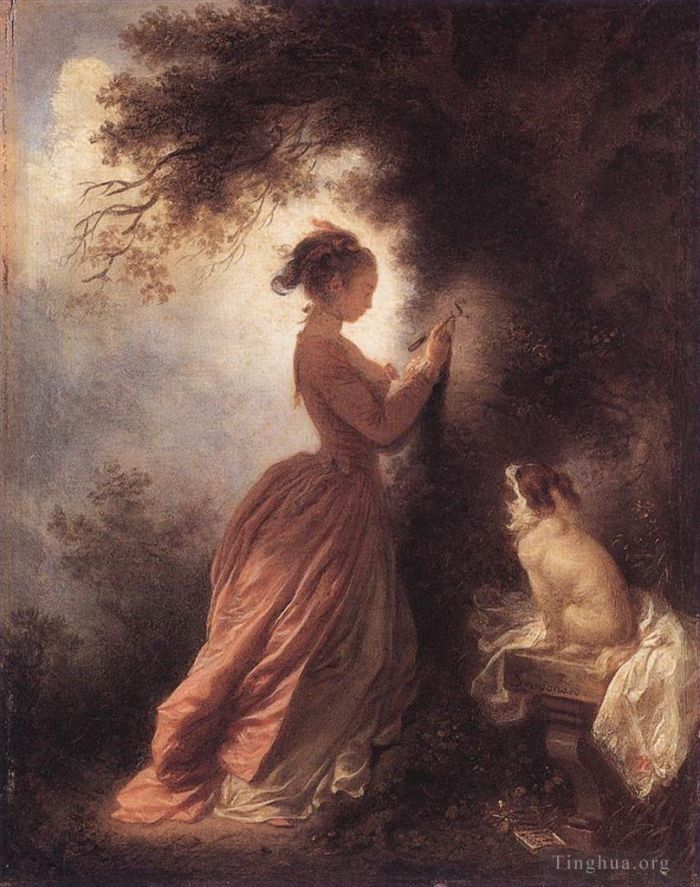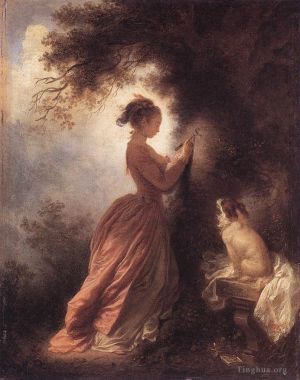The Souvenir
Jean-Honore Fragonard
- Price: Price on Request
- Art Type: Oil Painting
- Size:
- English Comments: 0
- International Comments: 0
- Creating Date:
- Introduction and Works of Jean-Honore Fragonard >>
Keywords:
Souvenir
Work Overview
- The Souvenir
Jean-Honore Fragonard
Date: 1775 - 1778
Style: Rococo
Genre: genre painting
Media: oil, canvas
Dimensions: 19 x 19 cm
A young girl carves the initial of her lover on the bark of a tree, while observed by her pet spaniel, the symbol of her fidelity. The theme reflects the increasing sensibilité of the second half of the eighteenth century. Its scale and careful technique also show Fragonard varying his style to echo the contemporary taste for Dutch seventeenth-century cabinet paintings, although he continued to animate such stylistic references with his own inimitable theatrical lighting, delicate draughtsmanship and calligraphic traceries of hair and foliage.
The painting is remarkable for his play with the idea of the artist's signature. It is signed at the lower right in a traditional way, but the woman also carbes the letter 'F' (and not 'S' as was thought at some point) into the tree, thus signing the painting from within the scene.
Fragonard was a pupil of Jean-Baptiste Chardin for a short time and later studied under the French pastoral painter Francois Boucher. He went on to win the Prix de Rome in 1752 which eventually allowed him to travel to Italy where he remained between 1756 and 1761. Whilst in Italy he developed a high admiration for the works of the artist Giambattista Tiepolo. During his travels around the Italian countryside he made many drawings of the Italian landscape. He was particularly taken with the Villa d’Este, which was situated at Tivoli near Rome and its Italian Renaissance gardens, parts of which were to feature in many of his future paintings.
In 1765 he became a member of the Académie in Paris with his historical picture in the Grand Manner entitled Coroesus Sacrificing himself to Save Callirhoe. By 1767 his style had changed and his works became more erotic. One example of this I featured in My Daily Art Display of March 29th when I gave you his beautiful work entitled The Swing, which is now housed in the Wallace Collection in London. In 1769 Fragonard married Marie-Anne Gérard who was a miniaturist and history painter. Marie-Anne’s sister Marguerite Gérard, studied under Fragonard and was to become one of the greatest French female artists. Fragonard and his wife had a daughter, Rosalie, two years later and she was often used as a model in her father’s paintings. The following year his son, Alexandre-Évariste, was born and he would also go on to be a talented painter and sculptor.
After his marriage, he also painted children and family scenes. His works were now almost all painted for private commissions from his wealthy private patrons. One such patron was Louis XV’s mistress, the beautiful Madame du Barry. For her he painted a set of four pictures entitled The Progress of Love, and art historians believe they were his greatest masterpieces. Sadly these paintings in his usual light-hearted Rococo style were, by 1773, the year he completed them, not looked on as being in vogue and they were returned to him. The appetite for Rococo works had almost died and with that Fragonard’s commissions began to dry up and he tried his hand at the “in vogue” Neoclassicism style but he was never able to replicate his Rococo achievements with this new style. Disheartened with the new turn of events, Fragonard left Paris in 1773 and went journeying around Europe visiting Austria Italy and Germany before returning home the following year.
His reliance on wealthy patrons, often members of Louis’s cour,t took a major blow with the onset of the French Revolution. Fragonard lost their patronage and in many cases his patrons lost their lives. As he was associated, through patronage, with the rich and noble he decided it was best to move with his family away from Paris and the bloody revolution and he went to Grasse, a commune in the south of the country where he was given shelter by his friend Alexander Maubert. He eventually returned to Paris and through the auspices of the Neoclassical painter, Jaques-Louis David, a staunch and important supporter of the French Revolution, got Fragonard a position at the newly-opened Louvre. David had been helped by Fragonard when he was a young and struggling painter and it had been time to return the favour.
Fragonard could never achieve the heights he reached during the Rococo period and died, virtually penniless, of a stroke in 1806 at the age of 74.
My featured painting today by Jean-Honoré Fragonard is entitled The Souvenir, which he completed in 1778. In the painting we see a young girl carving something on the trunk of a tree. According to the 1792 sale catalogue, the girl is Jean-Jacques Rousseau’s heroine Julie whom he wrote about in his novel of the same name, although its original title was Lettres de deux amans habitans d’une petite ville au pied des Alpes (“Letters from two lovers living in a small town at the foot of the Alps”). The figure of the girl which we see in profile is framed by the arching branches of the large tree. Her hair is decorated with pink ribbons and we see her upper body silhouetted against a white-grey sky.
The young girl has just received a letter from her lover which we see lying on the ground. So delighted with its contents and so besotted by her lover, she is carving his initials into the bark of the tree. By her side, sitting on a pedestal, which bears the artist’s name, is her pet spaniel, a symbol of fidelity. Her dog watches her intensely as her knife digs into the bark. There is an enchanting innocence about the girl and we wonder how the relationship with her lover will progress. Will their true love for each other triumph or will her innocent trust in true love end in sorrow? Fragonard has painted her sumptuous pink and white dress with great skill. Look how he has carefully and meticulously painted the folds of the satin material with all its different shading.
This is quite a small painting measuring a mere 25cms x 19cms but it is delightful and a thoroughly captivating work by the French master of Rococo spirit and who was once described as “the fragrant essence of the 18th century”. The painting by Fragonard mirrors the French literary and social happening of the eighteenth century known as sensibilité, which reached its peak between 1760 and the French Revolution. It was de rigueur for paintings to depict softer emotions of love, pity, sympathy and grief, a type of emotional sensitivity.
- Copyright Statement:
All the reproduction of any forms about this work unauthorized by Singing Palette including images, texts and so on will be deemed to be violating the Copyright Laws.
To cite this webpage, please link back here.
- >> English Comments
- >> Chinese Comments
- >> French Comments
- >> German Comments
- >>Report
- The Swing
- The Bathers
- The Lock
- Psyche and her two sisters
- Young girl reading
- The Storm
- Portrait of a Man
- Portrait of a Young Man
- A Boy as Pierrot
- Adoration of the Shepherds
- Marie Madeleine Guimard Dancer
- The Confession of Love
- Portrait of a man called the warrior
- The Small Park (Le petit parc)
- The Fountain of Love
- Music Lesson
- The Love Letter
- Young Woman Playing with a Dog
- A Young Scholar
- Coresus Sacrificing himselt to Save Callirhoe
- The Souvenir
- The Shepherdess
- Venus and Cupid
- Man Playing an Instrument The Music
- The Stolen Kiss
- Psyche showing her Sisters her Gifts from Cupid
- The Musical Contest









 Singing Palette
Singing Palette